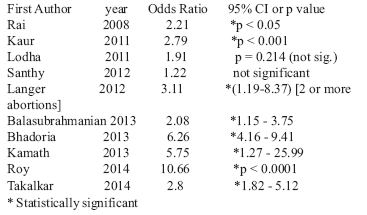Letter to the Medical Journal of Australia
To the editor, Medical Journal of AustraliaRe "Abortion and breast cancer risk for Australian women", MJA (201) 7, 6 October 2014, there is an obvious flaw in the study reported on by Kerry-Anne Phillips et al reassuring women that abortion is not associated with risk of breast cancer for Australian women, because the study did not distinguish between induced abortions and miscarriages. We have consistently pointed out that most first trimester miscarriages (other than those caused by accidents) do not raise breast cancer risk because the rise in estradiol levels is insufficient to cause breast cell multiplication (or to maintain the pregnancy). Therefore the Phillips study resulted in a dilution of the observed breast cancer risk.
Indeed it is the responsibility of cancer researchers to explain how induced abortions could not increase breast cancer risk because in healthy pregnancies there is a marked growth in immature breast cells and these cells do not mature and become cancer resistant until post 32 weeks gestation. Therefore a woman whose pregnancy is terminated prior to 32 weeks, whether by abortion or a premature birth, is left with more breast cells vulnerable to cancer. This is the same causation which results in non-parous women having a higher breast cancer incidence than women who have had full-term pregnancies.
Although Phillips et al refer to a recent controversy about the abortion-breast cancer link, the first study on this dates back to Japanese studies in the 1950s as correctly mentioned by Senator Eric Abetz. There have been over 80 studies since then, most showing a positive correlation between induced abortion and breast cancer incidence.
Furthermore, the dismissal of case-control studies on the assumption that healthy women routinely lie or forget theirabortions is insulting to women. There also appears to be a cavalier disregard by cancer organisations in Australia of the many studies from Asia, e.g. from Turkey, Iran, Bangladesh, Sri Lanka and India.
 The Nov. 2013 Dr. Huang 'meta' lists eighteen (18) statistically
significant studies reporting that prior abortions raise
breast cancer risk and zero significant studies reporting the
reverse. For India the significant Abortion/Breast Cancer
count is 8 (all reporting HIGHER breast cancer risk). Thus,
the total for China & India is 26 statistically significant studies
validating Abortion/Breast Cancer risk. If it was true
that prior abortions neither raise nor reduce breast cancer
risk, the odds of 26 statistically significant studies ALL reporting
higher risk is a million to one.
The Nov. 2013 Dr. Huang 'meta' lists eighteen (18) statistically
significant studies reporting that prior abortions raise
breast cancer risk and zero significant studies reporting the
reverse. For India the significant Abortion/Breast Cancer
count is 8 (all reporting HIGHER breast cancer risk). Thus,
the total for China & India is 26 statistically significant studies
validating Abortion/Breast Cancer risk. If it was true
that prior abortions neither raise nor reduce breast cancer
risk, the odds of 26 statistically significant studies ALL reporting
higher risk is a million to one.
Below is a partial list of the Indian studies which were positive for an association between induced abortion and breast cancer:
Babette Francis,
National & Overseas Co-ordinator
Endeavour Forum Inc.
The editors, Medical Journal of Australia, 277 Clarence St, Sydney 2000, (mja@mja.com.au) refused to publish this letter, please write and complain
The Medical Journal of Australia
Prof..Joel Brind's letter below was published in the Medical
Journal of Australia, online edition on 6 October 2014.
Why does MJA InSight author, Nicole McKee, claim a new Victorian study by Phillips et al. "has ruled out any link between abortion and breast cancer", when the opposite is true? Phillips et. al found no significant link, but did not distinguish between induced abortions and miscarriages. Miscarriages are known not to be linked to breast cancer, so studies that don't distinguish the two necessarily underestimate the risk. Nevertheless, Phillips et al. reported a 7% increase in risk among women with any abortions or miscarriages. Though not achieving statistical significance, this finding is hardly describable as "ruling out" a link. But there"s more. The Phillips study - published, as it was, through the "back door" as a mere letter - showed only selected data, such as a non-significant 3% decrease in risk for 'abortion before first full-term pregnancy' (mostly miscarriages), but not the other side of that statistic, i.e., (mostly induced) abortion after first full-term pregnancy. That statistic was (quite improperly) not shown. Could it be because it was perhaps a statistically significant 15-20% risk increase? And while we're on the subject (of covering up an abortion-breast cancer link), no one has ever explained why the 160% risk increase for induced abortion found among South Australian women by Rohan et al., was omitted from their 1988 paper, this strong and signficant risk increase only showing up 7 years later in another journal. And why is the MJA not concerned about the 13 studies in the last 6 years alone from South Asia, all reporting increased risk, by as much as 2,000%?
